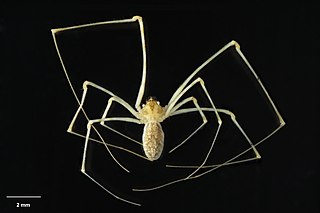
Araneoidea is a taxon of araneomorph spiders, termed "araneoids", treated as a superfamily. As with many such groups, its circumscription has varied; in particular some families that had at one time moved to the Palpimanoidea have more recently been restored to Araneoidea. A 2014 treatment includes 18 families, with the araneoids making up about 26% of the total number of known spider species; a 2016 treatment includes essentially the same taxa, but now divided into 17 families.

The Entelegynae or entelegynes are a subgroup of araneomorph spiders, the largest of the two main groups into which the araneomorphs were traditionally divided. Females have a genital plate (epigynum) and a "flow through" fertilization system; males have complex palpal bulbs. Molecular phylogenetic studies have supported the monophyly of Entelegynae.

Spelungula is a monotypic genus of South Pacific large-clawed spiders containing the single species, Spelungula cavernicola, or the Nelson cave spider. It was first described by Ray Forster, Norman I. Platnick, & Michael R. Gray in 1987, and has only been found in caves in the northwestern part of New Zealand's South Island.

Cryptachaea is a genus of spiders in the Theridiidae family.

Cambridgea decorata is a species of spiders in the genus Cambridgea found only in New Zealand. It is classified as "data deficient" under the New Zealand Threat Classification System. The only published records are of specimens collected in the 1940s from Parnell, and Waiheke Island (females). Both localities are in Auckland.

Pianoa is a monotypic genus of large-clawed spiders endemic to New Zealand. It contains a single species, Pianoa isolata, known commonly as the piano flat spider.
Calcarsynotaxus is a genus of Australian araneomorph spiders in the family Physoglenidae, and was first described by J. Wunderlich in 1995. As of September 2019 it contains two species, found in Queensland and Western Australia: C. benrobertsi and C. longipes.
Chileotaxus is a monotypic genus of Chilean araneomorph spiders in the family Physoglenidae, containing the single species Chileotaxus sans. It was first described by Norman I. Platnick in 1990, and is found in Chile. Originally placed with the Synotaxidae, it was moved to the Physoglenidae in 1973. The generic name is a contraction of "Chilean Synotaxus", and the specific name is an arbitrary combination of letters.
Mangua is a genus of araneomorph spiders in the family Physoglenidae that first described by Raymond Robert Forster in 1990. Originally placed with the Synotaxidae, it was moved to the Stiphidiidae in 2017.

Meringa is a genus of Polynesian araneomorph spiders in the family Physoglenidae that was first described by Raymond Robert Forster in 1990. Originally placed with the Synotaxidae, it was moved to the Physoglenidae in 2017.
Microsynotaxus is a genus of Australian araneomorph spiders in the family Physoglenidae that was first described by J. Wunderlich in 2008. As of September 2019 it contains two species, both found in Queensland: M. calliope and M. insolens.

Nomaua is a genus of Polynesian araneomorph spiders in the family Physoglenidae that was first described by Raymond Robert Forster in 1990. Originally placed with the Linyphiidae, it was moved to the Synotaxidae in 1990, and is now considered a senior synonym of Wairua.

Pahoroides is a genus of Polynesian araneomorph spiders in the family Physoglenidae that was first described by Raymond Robert Forster in 1990.
Paratupua is a monotypic genus of araneomorph spiders in the family Physoglenidae found in Victoria, Australia. It contains the single species, Paratupua grayi. Though it's sometimes misspelled Paratupa, the correct spelling is "Paratupua".
Physoglenes is a genus of Chilean araneomorph spiders in the family Physoglenidae that was first described by Eugène Louis Simon in 1904. It has been listed under several different families, including Leptonetidae, Pholcidae, Synotaxidae, and most recently, Physoglenidae.
Synotaxus is a genus of araneomorph spiders in the family Synotaxidae that was first described by Eugène Louis Simon in 1895. Originally placed with the tangle web spiders, it was moved to the monotypic family Synotaxidae in 2017.

Phycosoma is a genus of comb-footed spiders that was first described by Octavius Pickard-Cambridge in 1880.

Physoglenidae is a family of araneomorph spiders first described by Alexander Petrunkevitch in 1928 as a subfamily of Pholcidae. It was later moved to Synotaxidae until a study in 2016 showed that they formed a distinct clade.
Tupua is a genus of Tasmanian araneomorph spiders in the family Physoglenidae that was first described by Norman I. Platnick in 1990.











